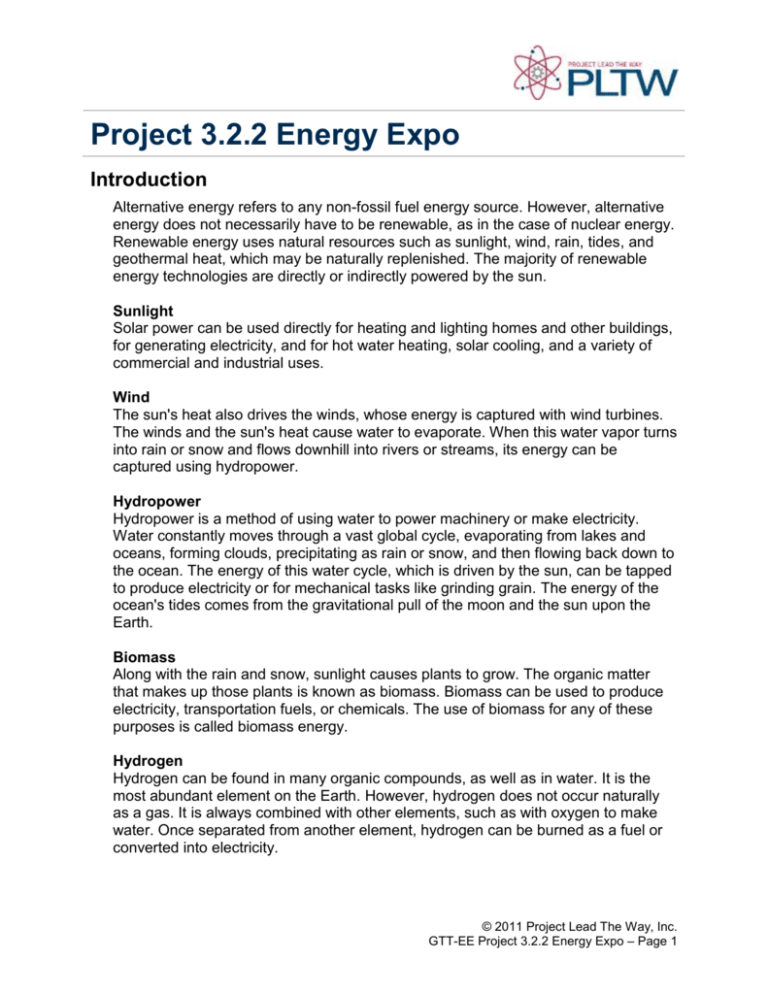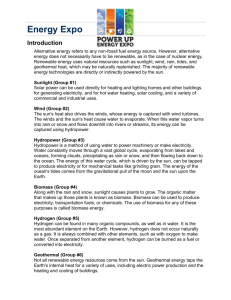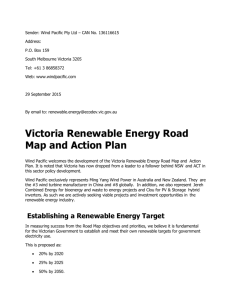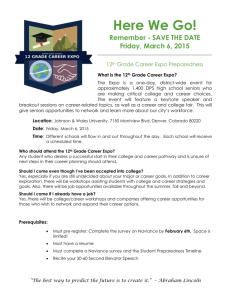Project 3.2.2 Energy Expo
advertisement

Project 3.2.2 Energy Expo Introduction Alternative energy refers to any non-fossil fuel energy source. However, alternative energy does not necessarily have to be renewable, as in the case of nuclear energy. Renewable energy uses natural resources such as sunlight, wind, rain, tides, and geothermal heat, which may be naturally replenished. The majority of renewable energy technologies are directly or indirectly powered by the sun. Sunlight Solar power can be used directly for heating and lighting homes and other buildings, for generating electricity, and for hot water heating, solar cooling, and a variety of commercial and industrial uses. Wind The sun's heat also drives the winds, whose energy is captured with wind turbines. The winds and the sun's heat cause water to evaporate. When this water vapor turns into rain or snow and flows downhill into rivers or streams, its energy can be captured using hydropower. Hydropower Hydropower is a method of using water to power machinery or make electricity. Water constantly moves through a vast global cycle, evaporating from lakes and oceans, forming clouds, precipitating as rain or snow, and then flowing back down to the ocean. The energy of this water cycle, which is driven by the sun, can be tapped to produce electricity or for mechanical tasks like grinding grain. The energy of the ocean's tides comes from the gravitational pull of the moon and the sun upon the Earth. Biomass Along with the rain and snow, sunlight causes plants to grow. The organic matter that makes up those plants is known as biomass. Biomass can be used to produce electricity, transportation fuels, or chemicals. The use of biomass for any of these purposes is called biomass energy. Hydrogen Hydrogen can be found in many organic compounds, as well as in water. It is the most abundant element on the Earth. However, hydrogen does not occur naturally as a gas. It is always combined with other elements, such as with oxygen to make water. Once separated from another element, hydrogen can be burned as a fuel or converted into electricity. © 2011 Project Lead The Way, Inc. GTT-EE Project 3.2.2 Energy Expo – Page 1 Geothermal Not all renewable energy resources come from the sun. Geothermal energy taps the Earth's internal heat for a variety of uses, including electric power production and the heating and cooling of buildings. In this project your teacher will divide you class into teams. Each team will research one type of renewable energy. Your team will design, build, and test a model that uses your assigned form of renewable energy. The last day of this project will be an Energy Expo where your team can teach the rest of the students in your class and possibly other students or adults about your renewable resource. Equipment GTT notebook Pencil Display boards Adhesives – glue, tape, zip ties, etc. (to attach objects to display board) Supplies to make models or prototypes fischertechnik® components Computers for Internet research Book resources Procedure Your teacher will help divide your class into teams. Everyone on your team is expected to become an expert in the renewable resource that you are researching and prototyping. The Energy Expo will be on ______________ (fill in date). At the Energy Expo your team will be evaluated using the Grading Rubric, so make sure that you have met all of the criteria. 1. Research your renewable energy source, then decide what your team will model or prototype that uses this renewable energy source. 2. List all supplies and equipment necessary to make your model or prototype and discuss with your teacher where those resources can be located. 3. Collect all materials. 4. Design, build, and test the model or prototype. Make improvements and re-test. 5. Prepare Energy Expo display. Choose carefully what to include in your display. A simple display with a few key items is often most effective. Some of the possible items to include are listed below. Not all of these will apply to your project. Charts, graphs, or tables describing your research Models, prototype, photographs, illustrations Description of how your energy source works, its applications, advantages and disadvantages Description of how your model or prototype works STEM careers involved Team engineering notebook © 2011 Project Lead The Way, Inc. GTT-EE Project 3.2.2 Energy Expo – Page 2 6. Participate in the Energy Expo as a presenter and as an observer. Take notes in your GTT notebook about each of the other renewable resource displays. Conclusion 1. Which alternative energy source(s) are not affected by the sun? Why? 2. Which alternative energy source(s) creates electricity, but not by turning a turbine? 3. Which alternative energy sources are practical for use in business, home, or schools now? Give examples of how they are used. 4. With all of these options for renewable energy, why is there still an energy crisis? 5. “Green technology, green construction, green energy, buying green, working green, green government” – in your own words, describe what is meant by these terms. © 2011 Project Lead The Way, Inc. GTT-EE Project 3.2.2 Energy Expo – Page 3








